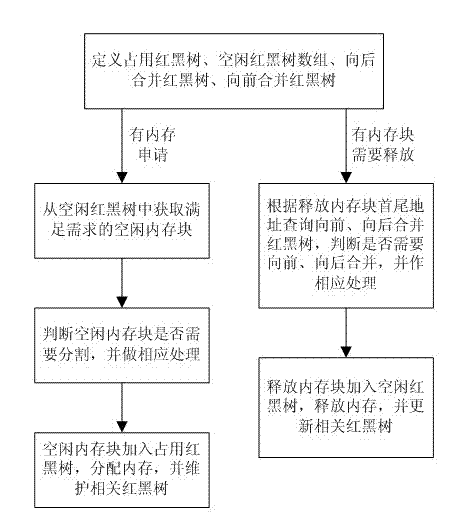Memory algorithm facing real-time system
A real-time system and memory technology, applied in the field of memory algorithm, can solve the problem of low memory utilization
- Summary
- Abstract
- Description
- Claims
- Application Information
AI Technical Summary
Problems solved by technology
Method used
Image
Examples
Embodiment Construction
[0024] The present invention faces the memory algorithm of real-time system, such as figure 1 As shown, when searching for the target memory block, it is no longer limited to the traditional linked list traversal search method, but uses the red-black tree data structure to quickly find the required memory block, and realizes the process of releasing and reclaiming the memory block. It has high time efficiency. The algorithm defines the following four types of red-black trees:
[0025] Occupied red-black tree : It is used to store the information of the occupied memory block, including size, physical address, memory ID, etc. At the same time, the memory ID of the memory block is used as a comparison rule. When the program releases the memory, it quickly locates the memory block according to the memory ID and releases the memory. .
[0026] free red-black tree array :definition arrive A total of 18 red-black trees, corresponding to the memory size marked as 1, 2, 3, 4,...
PUM
 Login to View More
Login to View More Abstract
Description
Claims
Application Information
 Login to View More
Login to View More - Generate Ideas
- Intellectual Property
- Life Sciences
- Materials
- Tech Scout
- Unparalleled Data Quality
- Higher Quality Content
- 60% Fewer Hallucinations
Browse by: Latest US Patents, China's latest patents, Technical Efficacy Thesaurus, Application Domain, Technology Topic, Popular Technical Reports.
© 2025 PatSnap. All rights reserved.Legal|Privacy policy|Modern Slavery Act Transparency Statement|Sitemap|About US| Contact US: help@patsnap.com

